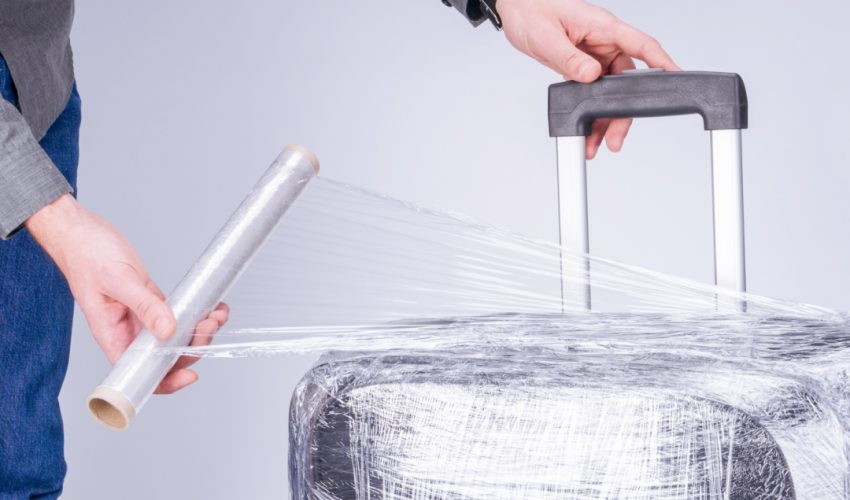
Using cling wrap for luggage has become an increasingly popular trend for travelers looking to protect their bags during transit. This simple, cost-effective solution helps safeguard luggage from scratches, dirt, and even moisture, offering an added layer of security. Cling wrap for luggage is durable elastic film stretches easily to band securely makes it hard to your bag to be stolen. Travelers can easily find cling wrap for luggage in supermarkets, big-box retailers, or stores like PWP Stretch Film, making it a convenient option for those looking to wrap their suitcases at home. Compared to expensive commercial services available at airports, using cling wrap for luggage is an affordable alternative that ensures your bags stay in good condition throughout your journey while avoiding unnecessary costs.
Why Choose Our Stretch Film Over Competitors?
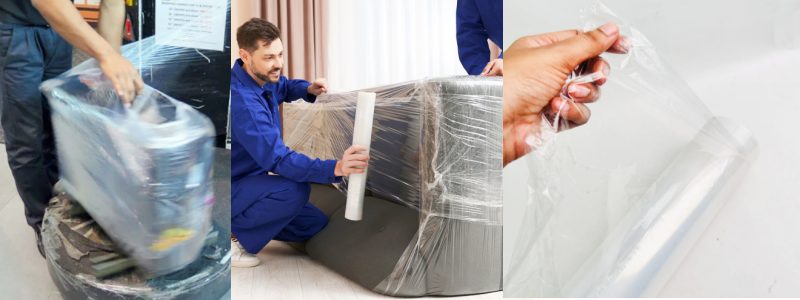
| Attribute | Details |
|---|---|
| Type | Cling Wrap for Luggage |
| Material | PE, LLDPE |
| Place of Origin | Fujian, China |
| Brand Name | PWP Stretch Film |
| Processing Type | Casting, Multiple Extrusion |
| Thickness | 12 micron ~ 38 micron |
| Width | 100mm ~ 1800 mm (customizable) |
| Length | 30 m ~ 3000 m (customizable) |
| Color | Transparent, Black, Red, Blue, Green, Yellow |
| Elongation at Break | 300% ~ 500% |
| Tear Strength | High |
| Packing | Roll Packing (1/4/6 rolls per carton), 5-layer master carton with pallets |
| Certificates | ISO9001:2015, ROHS |
| Applications | Luggage Wrapping, Baggage Packaging, Airport Logistics |
| Machine Compatibility | Pre-stretch film compatible with automatic wrapping machines |
| Sample Availability | Free Samples Available |
| MOQ | 100 kg |
| Customizable Features | Color, Thickness, Width, Length, Logo Printing |
| Key Selling Points | Durable, Moisture Proof, High Gloss Surface, Easy Application |
When selecting cling wrap for wrapping luggage, it’s important to consider specific size and material factors to ensure it effectively protects your belongings. Here’s a detailed description:
By considering these factors, you can choose a cling wrap that ensures your luggage is well-protected during travel or storage.
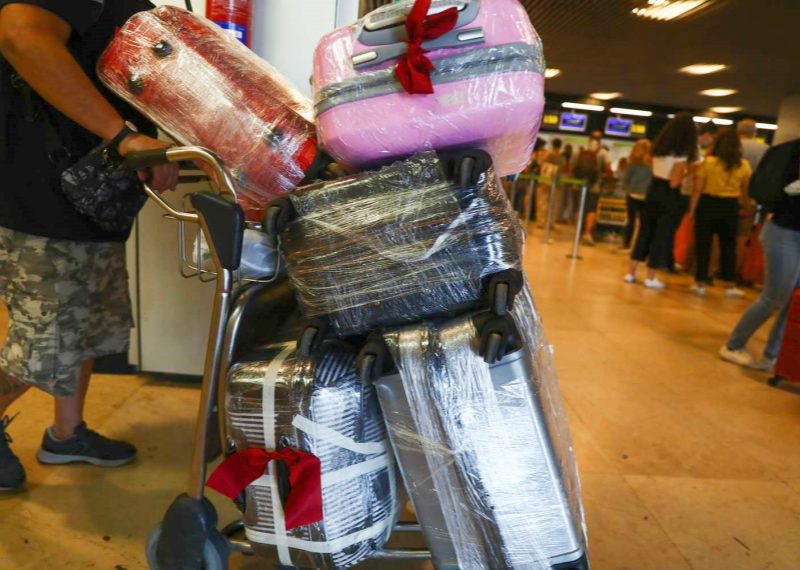
Using cling wrap for luggage has become a common practice among travelers who want to ensure their suitcases remain protected during transit. Below are several reasons why cling wrap for luggage is an excellent choice for safeguarding your bags.
One of the key benefits of using cling wrap for luggage is its ability to prevent scratches, scuffs, and other damage. Luggage often endures rough handling during transportation, and using luggage wrapping film can help preserve the integrity of your suitcase by acting as a protective barrier against external wear and tear. This is especially important for those with hard-shell suitcases, which can easily get scratched.
Travelers frequently encounter unpredictable weather conditions, and cling wrap for luggage provides an effective solution to keep your belongings dry and free from dust or dirt. Whether you are caught in the rain while waiting for transport or your bags are left on an open tarmac, this layer of protection ensures your luggage remains clean and dry.
Another important reason to use luggage wrapping film is the added security it provides. The wrap creates an extra layer of difficulty for potential thieves, who may avoid tampering with wrapped luggage due to the extra effort involved. While parcel wrapping film is not a guarantee of theft prevention, it certainly acts as a deterrent for opportunistic theft, making it a valuable security measure.
Compared to airport wrapping services, cling wrap for luggage is a highly cost-effective alternative. You can purchase cling wrap from stores like PWP Stretch Film and use it for multiple trips, reducing the overall expense of keeping your luggage secure. It’s an affordable option that delivers peace of mind without breaking the bank.
When considering more durable wrapping options, stretch wrap for luggage is a popular choice. This type of film, often made from stronger materials, provides an even tighter seal around your suitcase, offering enhanced protection from damage, weather, and tampering. Additionally, stretch wrap length can vary, allowing you to select the right amount for your specific needs. Stretch wrap is commonly used by airport services but can also be applied at home for long-distance travel.
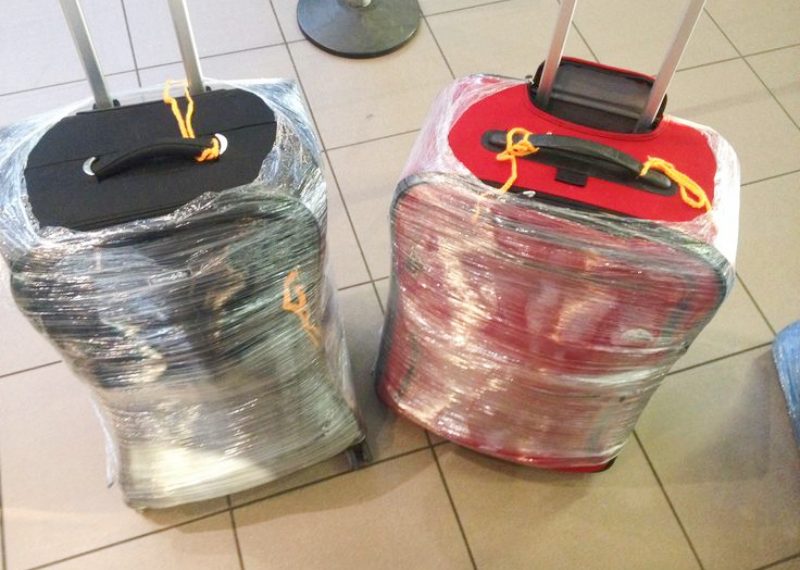
Finding cling wrap for luggage is simple and convenient, as it’s available in a variety of stores and locations. Whether you’re preparing for a trip or looking for a cost-effective alternative to airport wrapping services, here’s where you can easily source the materials you need.
If you’re searching for cling wrap for luggage near me, local supermarkets, convenience stores, and big-box retailers are ideal places to start. Many grocery stores stock cling wrap in the paper and plastic essentials aisle, alongside food storage items like aluminum foil and zip-lock bags. Specialty stores that sell moving and packing supplies may also carry stronger options like luggage stretch wrap, which is designed for more durable wrapping needs.
In addition to these local options, packaging supply stores often offer luggage stretch film wrapping, including premium options like shield wrap stretch film. Known for its durability, this type of film is particularly useful for travelers seeking extra protection for their luggage during long-haul flights or rough transit.
For a more specific shopping experience, PWP Stretch Film is a popular destination for purchasing cling wrap for luggage. PWP Stretch Film provides a wide selection of cling wrap products, both in-store and online. You can find various options, including hand stretch film, luggage stretch wrap, and even industrial-grade wraps suitable for longer trips or more fragile luggage.
PWP Stretch Film also offers products like luggage stretch film wrapping, which provides superior strength and flexibility, ensuring that your luggage is well-protected during your journey. Additionally, PWP Stretch Film carries related items such as food storage bags and containers, making it a one-stop shop for all your travel and packing needs.
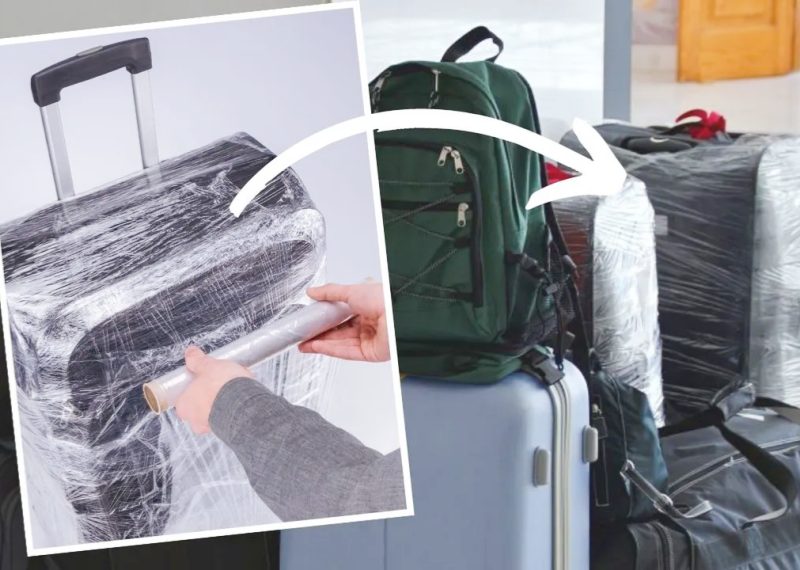
Using cling wrap for luggage is an excellent way to protect your belongings during travel. To ensure that your suitcase is securely wrapped and well-protected, follow this step-by-step guide that outlines the process from start to finish.
When choosing cling wrap for luggage, you’ll want to select between household cling wrap and commercial-grade options. Household cling wrap is lightweight and easy to find, making it suitable for shorter trips or minimal protection. However, if you’re looking for stronger coverage, commercial-grade cling wrap for luggage provides a thicker, more durable layer of protection.
Begin by placing your luggage upright. Start at the center of one of the larger sides of the suitcase and begin wrapping horizontally around the bag. Be sure to cover all surfaces evenly. Move the roll of cling wrap for luggage over the front, back, and sides of the suitcase, ensuring a snug fit.
Apply slight tension to the wrap as you go to ensure a tight seal. Continue wrapping until you’ve covered all areas of the luggage, including the top and bottom. This will help secure your belongings and protect against external elements.
Once you have fully wrapped the suitcase, you’ll need to cut small holes for the handles and wheels. Using a pair of scissors or a sharp blade, carefully cut around the areas where the handles and wheels are located. Be cautious to only cut enough wrap to allow easy access without compromising the overall protection.
After wrapping the luggage, it’s important to secure the ends of the wrap. Tuck the loose ends of the cling wrap into the folds or use a small piece of tape to ensure the wrap stays in place throughout your trip. This ensures durability and prevents the wrap from unraveling during transport.
If you prefer not to wrap your suitcase at home, you can explore luggage wrapping near me services at the airport or nearby stores. These services use professional-grade equipment and cling wrap for luggage to ensure a high-quality, tight wrap, offering added protection for long-haul trips or delicate luggage. Many airports offer these services for a fee, providing peace of mind for travelers who want extra security.
While using cling wrap for luggage is a popular method for protecting your suitcase during travel, there are several other effective alternatives to consider. These options can offer additional protection, sustainability, or convenience, depending on your travel needs.
Instead of solely relying on cling wrap for luggage, you can use food storage bags or containers inside your suitcase to protect individual items. Placing valuables, toiletries, or delicate items in sealed storage bags ensures they remain secure and organized, reducing the chance of damage or spills during transit. Hard-shell containers can provide extra protection for breakable items like electronics or souvenirs, giving you peace of mind without the need for external wrapping.
If you’re looking for a more durable alternative to cling wrap for luggage, consider using industrial cling wrap or luggage covers. Industrial cling wrap is thicker and more robust than standard cling wrap, making it ideal for long-distance travel or fragile luggage. It provides a tighter seal and better protection against weather, scratches, and tampering.
Alternatively, luggage covers made from durable fabrics are another excellent option. These covers are reusable, provide full coverage, and are designed specifically to fit your suitcase. They can protect against dirt, moisture, and minor damage while offering a more eco-friendly option compared to disposable cling wrap.
For frequent travelers seeking a more sustainable alternative to cling wrap for luggage, luggage gloves are an innovative and eco-friendly solution. Luggage gloves are reusable fabric covers that fit snugly over your suitcase, offering protection from scratches and dirt while allowing easy access to handles and wheels. These gloves are often made from stretchable, water-resistant materials, making them durable and long-lasting. By using luggage gloves, travelers can reduce their reliance on plastic wraps and contribute to more sustainable travel practices.
While cling wrap for luggage is convenient, exploring these alternatives can offer better protection, sustainability, or even added functionality, depending on your specific travel needs.
Using cling wrap for luggage offers a convenient way to protect your belongings, but it’s important to consider the environmental impact of single-use plastic. As more travelers become eco-conscious, understanding the sustainability aspects of cling wrap for luggage can help reduce its environmental footprint.
While most cling wrap for luggage is made from plastic, recycling options can be limited. However, some facilities accept plastic films for recycling, so it’s essential to check local recycling centers for availability. Proper disposal is crucial to prevent plastic waste from accumulating in landfills or contributing to ocean pollution. If you decide to use cling wrap for luggage, make sure to dispose of it responsibly or reuse it for future trips. Reusing plastic wrap when possible helps minimize waste and reduces the need for new materials.
For travelers seeking more eco-friendly options, there are several sustainable alternatives to cling wrap for luggage. Reusable fabric covers, often called luggage gloves, are a great way to protect your suitcase while avoiding plastic waste. These covers can be washed and reused multiple times, making them a more sustainable choice. Another option is biodegradable wrapping materials, which break down more quickly and have a lower environmental impact than traditional plastic wrap. By exploring these alternatives, you can reduce your environmental footprint while still ensuring your luggage remains protected during travel.
While cling wrap for luggage offers convenience, considering environmentally friendly practices such as recycling or opting for reusable alternatives is a great way to contribute to a more sustainable travel experience.
Cling wrap is a quick and inexpensive solution for one-time use, but its drawbacks, especially regarding environmental impact, inconvenience during security checks, and lack of reusability, may outweigh its benefits for many travelers. Considering alternatives like reusable luggage covers or TSA-approved locks might be a more practical and eco-friendly choice.
When using cling wrap for luggage, it’s important to take security protocols into account, especially if you’re traveling through airports where inspections are common. While wrapping your luggage can deter theft and offer protection, there are a few considerations you should keep in mind regarding security checks.
One of the key security concerns when using cling wrap for luggage is the possibility of it being removed during security screenings. The Transportation Security Administration (TSA) and other airport security agencies are required to inspect luggage that triggers their detection systems. If your wrapped luggage is flagged for inspection, the security officers may need to cut through the cling wrap to access the contents inside. While cling wrap for luggage adds an extra layer of protection, it cannot prevent these mandatory inspections.
This means that even if you carefully wrap your luggage, there’s a chance that it will need to be rewrapped or left unwrapped if security needs to open it. If you’re wrapping your luggage for added security, consider carrying extra wrap or using an alternative method, such as a luggage cover, so that you can easily reapply protection after a security check.
While cling wrap for luggage is a useful tool for preventing tampering and safeguarding your bags, travelers should be aware that security checks may result in the removal of the wrap. Always prepare for this possibility and have a plan for securing your luggage after inspection.
You can buy plastic wrap for luggage at most major airports, luggage stores, or online platforms. Airports typically have dedicated wrapping stations that offer professional wrapping services. These are often located before the security check areas. For a DIY approach, heavy-duty plastic wrap can also be purchased from home improvement stores or online retailers. Look for wrap that’s specifically designed for luggage to ensure it’s sturdy enough to withstand the rigors of travel.
While it’s physically possible to use regular cling wrap (the type used in kitchens) for wrapping luggage, it’s not recommended. Cling wrap is much thinner and less durable than the plastic wrap specifically designed for luggage. It might not hold up well during the handling process, potentially leaving your luggage unprotected. For better security and protection, opt for professional wrapping services at the airport or use commercial-grade plastic wrap intended for luggage.
Yes, TSA does allow passengers to travel with wrapped luggage. However, it’s important to note that if your bag is selected for additional screening, TSA officers may need to unwrap the luggage to inspect its contents. After the inspection, TSA does not rewrap the luggage. Therefore, while wrapping can add an extra layer of protection, it might be removed during the security process, and you would need to wrap it again if desired.
Many Filipinos, as well as travelers from various parts of the world, wrap their luggage for several reasons including added protection against theft, damage, and tampering. Wrapped luggage can also prevent the contents from spilling out in case of a zipper failure. Moreover, the extra layer of plastic can help shield the luggage from scratches and stains. For many Filipino travelers, wrapping also signifies making sure their balikbayan boxes or suitcases filled with gifts and pasalubong are safely delivered to their loved ones.
The cost of plastic wrapping luggage at the airport can vary depending on the location and the size of the luggage. On average, prices range from $10 to $20 per bag. Some airports might charge more for larger bags or offer package deals for wrapping multiple pieces of luggage. It’s advisable to check the specific rates at the airport you’ll be using or consider purchasing your own wrap for a potentially cheaper, albeit less convenient, option.
Wrapping suitcases in clingfilm (or plastic) is a protective measure. It helps safeguard luggage from scratches, scuffs, or dirt during transit. Additionally, it acts as a deterrent against tampering or theft, as the plastic wrap makes it obvious if someone tries to open the suitcase. For travelers with soft-sided luggage or those carrying delicate or valuable items, plastic wrapping adds an extra layer of security and peace of mind. Some people also use it to prevent luggage from getting wet in case of rain or mishandling.
Yes, it is okay to wrap your luggage, and many airports even offer professional wrapping services. It is considered safe and practical for protecting your belongings. However, some airlines or airport security might need to inspect your luggage, which may require removing the plastic. To avoid issues, use wrapping services available at the airport, as they typically provide easy-to-remove and rewrap options. Always check airline or airport policies to ensure compliance.
The cost of plastic wrapping luggage varies depending on the airport and country. On average, wrapping a standard suitcase can cost between $10 and $25. Larger or oversized bags may incur additional fees. Some airports in regions like Europe or the U.S. might charge on the higher end, while services in other parts of the world may be more affordable. If you’re on a budget, consider purchasing reusable luggage covers as an alternative.
No, it is not mandatory to wrap your luggage for a flight. Wrapping is a personal choice for added protection and security. Airports and airlines generally do not require it, and they accommodate both wrapped and unwrapped luggage. However, in certain countries or regions where luggage theft or tampering is a concern, travelers may prefer wrapping for safety. Always follow security screening requirements to avoid delays.
Many Europeans wrap their luggage in plastic for practical and security reasons. Europe has a high volume of travelers, and luggage can be subject to wear and tear due to frequent handling. Additionally, wrapping helps deter theft, especially when transiting through busy airports. In some cases, travelers use it to protect bags from rain or snow. The trend is also influenced by the availability of wrapping services at most European airports, making it a convenient choice for travelers.

My name is James Thompson, and I’m the editor of this website dedicated to Stretch Film, Pallet Wrap, and Stretch Wrap products.
My passion for packaging began when I noticed the challenges companies face in securing their products efficiently for transportation and storage. This inspired me to delve deep into the world of stretch films and pallet wraps, exploring the latest technologies and best practices.
I aim to provide valuable insights, practical tips, and up-to-date industry trends to assist you in making informed decisions. Whether you’re a small business owner or part of a large corporation, my goal is to support you in optimizing your operations and ensuring your products reach their destination safely.
Thank you for visiting, and I look forward to accompanying you on your journey toward better packaging solutions.
Comments are closed